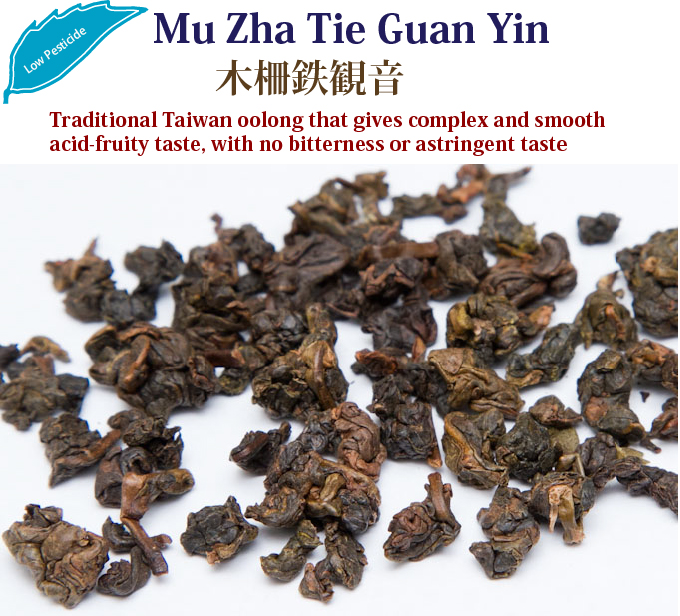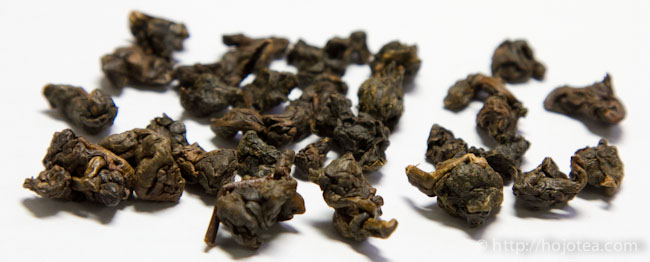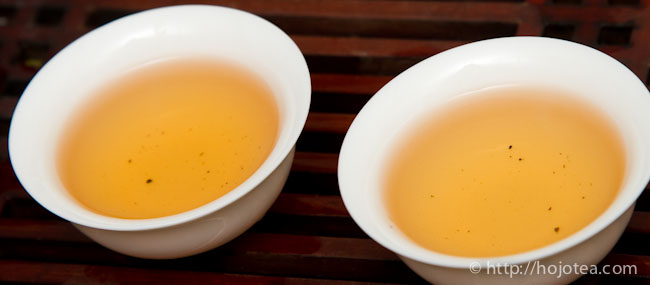
Thank you for visiting HOJO website. If you have any enquiry, please feel free to get in touch with us at
▼ Akira Hojo
▼ Hojo Newsletter
▼ HOJO FACEBOOK





HOME > Oolong Tea >Deep Fermented Dong Ding Oolong

Mu Zha Tie Guan Yin originated from Northern Taiwan, Wen Shan District, Taipei City. According to the record, the tea plantation in Northern Taiwan started more than 300 years ago. During Qing Dynasty, around 1796 to 1820, record mentioned that tea tree was brought by a tea merchant named Ke Chao from Wuyi in Fujian and planted in Wen Shan District of Northern Taiwan. Wen Shan is not just today's famous tea production area, it is also the earliest birthplace of the Taiwan tea. About 200 years ago, Tie Guan Yin cultivar was brought from Anxi of Fujian and planted in Mu Zha of Wen Shan District. Thus, the Mu Zha is the earliest birthplace of Taiwan Tie Guan Yin. In the beginning, the tea tree was planted in Zhang Hu hill. Later in 1919, the two brothers of Zhang family, Zhang Nai Miao and Zhang Nai Qian brought back the tea trees from Anxi and started the plantation of Tie Guan Yin cultivar in a larger scale in Mu Zha.

When we look at its dry leaf, each leaf is rolled-up firmly with dark brown colour, unlike green TGY that dominating the market. Upon brewing, each leaf uncurls very slowly. You will notice its wrinkled surface. Traditionally, the rolling and baking process of Mu Zha TGY is different from other high mountain oolong tea. After the fermentation process, the leaves will undergo primary drying process to partially halt the oxidation of enzyme. The drying process is carefully managed so as not to completely dry the leaves. And then, the semi-dried leaves are bagged in a cotton bag and rolled to form a round-ball shape. This bag of tea leaves is then rolled for 20 to 30 times. In between the rolling, the bag is opened to remove the tea leaves and then dismantle the block of tea leaves, and then continue the bagging and rolling process. After a few rounds of bagging and rolling, the tea leaves already cool down. It's then place into the frying pan and re-heated at 70 to 80 degree Celsius before the next rounds of bagging and rolling is continued. After this series of process, the tea leaves are then undergone the second rolling and baking process. The tea leaves are heated to 70-80 degree Celsius and then it's rolled by hand. It's repeated for 10 to 20 times. This series of step are repeated for many times until the tea leaves are curled and tightly shaped. The tea components are converted into substances contributed to flavour and taste thanks to the roasting temperature.

Muzha Tie Guan Yin has a complex and smooth acid-fruity taste, with no bitterness or astringent taste. The tea liquid has crimson colour.
In the long run, you may observe a thick layer of scale accumulated inside your kettle. Our mother usually taught us to wash and remove it with citric acid. But please do not even try to remove the scale. Scale consists of minerals that exist in the water. The mineral composition is reflected from the water you used. If you remove the scale, the mineral ion balance between scale and water is destroyed. This balance is called buffer effect in science. The flavor and taste will seriously run out and you won’t be able to get previous taste and flavor for a long time. It is also important to stick to the same type of water whenever brewing tea. If source of water is changed, it carries different type of minerals. It will affect the mineral ion balance too.
Go to further information about suitable water for brewing tea >>
To determine the quantity of tea leaves to be used, we divide the volume of water by 50. For example: the volume of teapot = 200ml; 200ml/50 =4g. You need to measure 4g of tea leaves for 200ml of water.
Based on the above ratio between hot water and the weight of tea leaf, the brewing time is as follow.
1st: 55 seconds
2nd 45 seconds
3rd 55 seconds
4th 65 seconds
5th 75 seconds
6th 85 seconds
Note: Please remove the lid while you are waiting for subsequent brewing. Tea leaf will be over steamed and get oxidized if the lid is not removed.
In order to enjoy oolong tea, always ensure that the water temperature is very hot. Use boiling water and rinse tea pot with boiling water to keep it hot.
Once a bag of tea is opened, please finish it within 3 months if you wish to enjoy its freshness. From the medical point of view, it is safe to consume the tea even if it is kept for a few years. However the freshness disappears if it is kept for too long. Tea must be tightly sealed before it is kept. Tea should be kept in ambient and dry conditions such as in the living room, but it must be completely away from humidity. Tea should not be kept in the kitchen as the environment is very humid. Avoid enclosed area such as inside the cupboard or drawer as these places are damp. Also avoid opening the bag of tea in humid atmosphere. It is recommended to open the bag during a sunny day or under air-conditioned atmosphere. Once tea leaves absorb moisture, deterioration of tea will be triggered within a few days. Tea will then give an astringent taste, sometime it tastes sour. The fresh aroma also becomes weaker.
The quality of tea lasts longer if it is kept in the fridge. However we strongly recommend you not to keep tea in the fridge. When tea is withdrawn from the fridge, there is usually condensation. Once tea is exposed to moisture during condensation, the quality will deteriorate within a few days. The higher moisture content in the tea leaves will trigger oxidation and it will completely destroy the quality of tea.
Here’s one frequently asked question: what happens if bag is sealed using tape or tea is packed in zipper bag and kept inside the fridge?
For your information, these simple sealing methods are not sufficient. When the bag is withdrawn from the fridge, it is cold inside the bag and therefore causes negative pressure. Air will be drawn from outside and condensation will occur. In addition, if the bag is taken in and out from the fridge very often, this will cause heat stress to the tea leaves as temperature is increased and decreased very frequently. If tea is kept in the fridge, when it is withdrawn from the fridge, it is necessary to leave it in ambient atmosphere for more than 24 hours in order to warm up the tea leaves. Based on our experience, 12 hours is not long enough. We may think tea is warmed up, but inside the bag, the tea leaves are still cold due to insulation effect.

Please feel free to send us e-mail for enquiry at:

 |
We accept various kinds of credit card through Paypal.
Only if customer prefer other option of payment, we suggest "Bank Transfer".
Various choice of shipping method
EMS, SAL, Small Packet, Small Packet (SAL) Yamato Express and Surface
For shipping tea, we usually suggest small air parcel, the estimated shipping cost of tea in 100g (with wrapping material ) is
Small Parcel
USA JPY 600, EU JPY600 and Asia JPY470
Small Packet (SAL)
USA JPY380, EU JPY380 and Asia JPY320
The shipping fee to oversea by small air parcel happens to be even cheaper than domestic shipping fee in Japan.
For your information, some countries, EU in particular imposes custom duty. We need buyer to bare the duty. We are sorry, but we cannot change the amount on the invoice, and we do not mark any packages as gifts. We will strictly follow the custom regulation.
A GIFT FROM THE MOUNTAIN
since 2006
Copyright (C) 2006-2007 HOJO co.,ltd. All Rights Reserved.